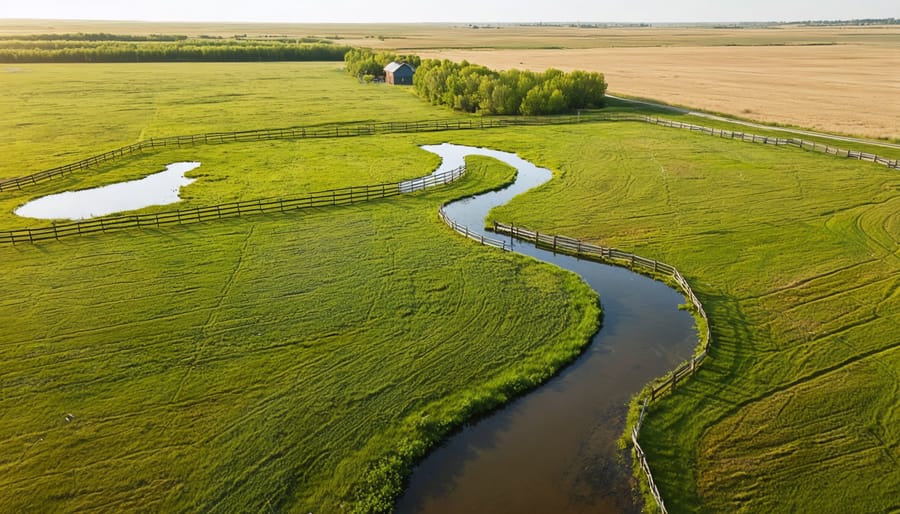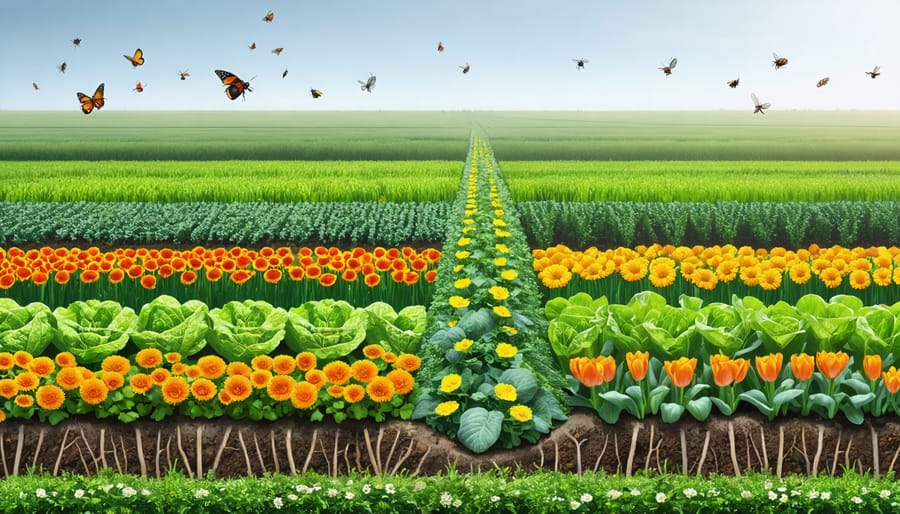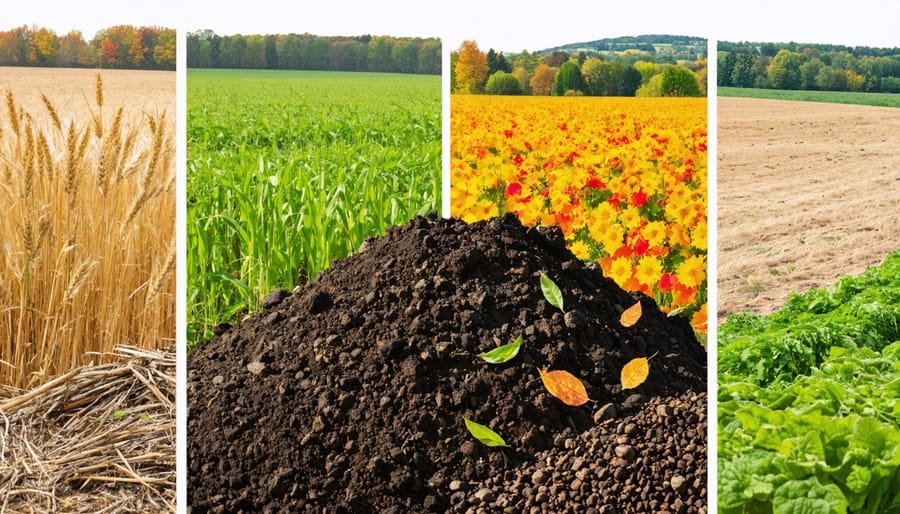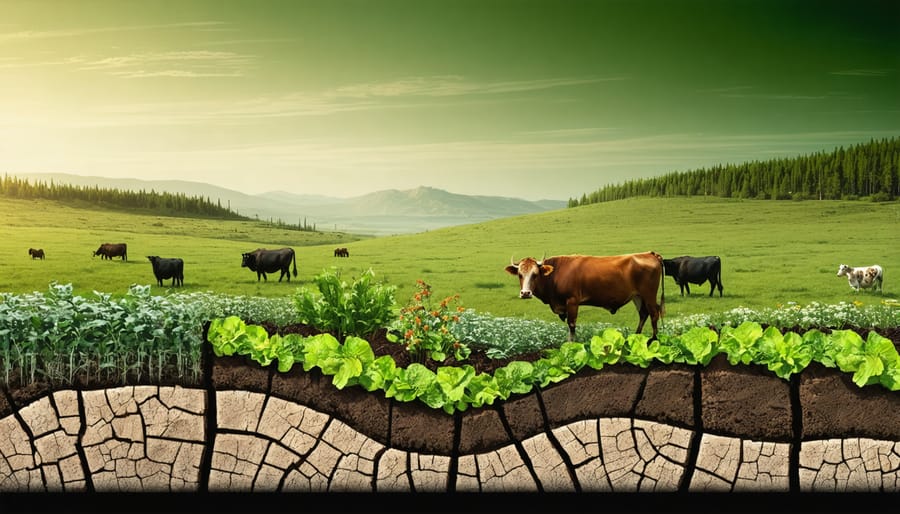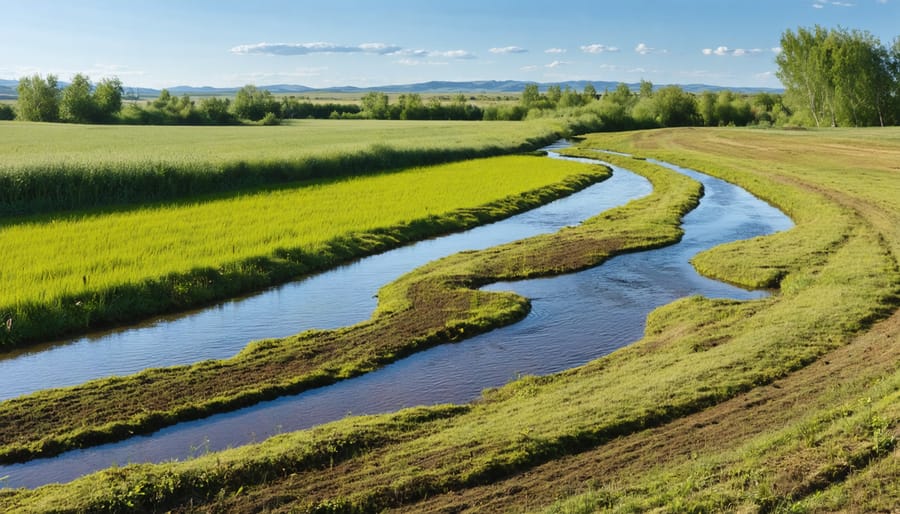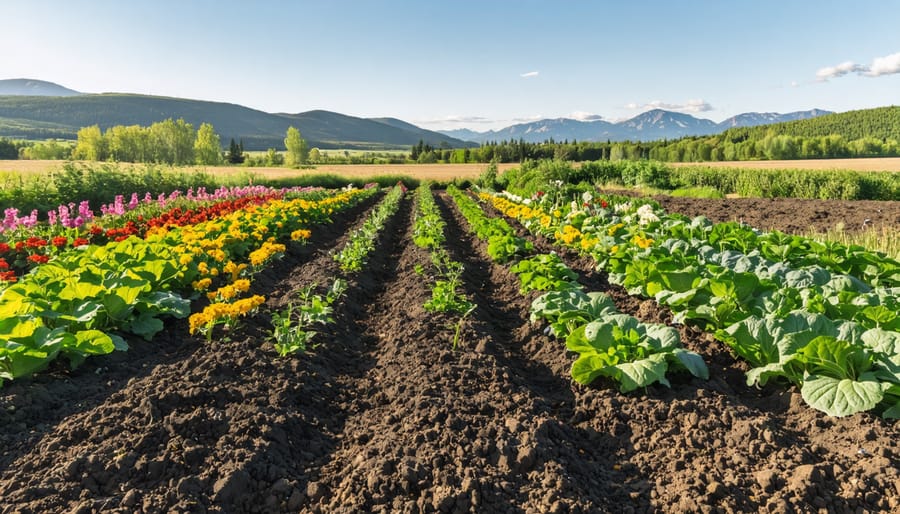Capture every drop of rainfall in swales, ponds, or earthworks positioned along contour lines—this slows water movement across your land and allows it to infiltrate soil rather than run off. Install these features at the highest points of your property first, creating a cascade effect that rehydrates landscapes from top to bottom.
Build organic matter in your soil to increase water-holding capacity by 20,000 liters per hectare for every 1% increase in soil organic carbon. Apply compost, practice no-till farming, and maintain living roots year-round through cover cropping. Alberta farmers using these regenerative agriculture principles report soil moisture retention improvements within two growing seasons.
Integrate livestock rotation to activate the water cycle through hoof action and manure distribution. Move cattle every 1-3 days during growing season, allowing trampled plant material to create soil armor that reduces evaporation by up to 30% while stimulating new growth that pumps water through plant transpiration.
Establish riparian buffers with native vegetation along waterways and low-lying areas. These zones filter runoff, recharge aquifers, and create microclimates that increase humidity and reduce wind—critical factors in Canada’s Prairie provinces where evapotranspiration rates challenge conventional water management.
Water regeneration isn’t about importing resources or installing expensive infrastructure. It’s about redesigning your farm to work with natural hydrological processes, transforming your land from a surface that sheds water into a living sponge that captures, stores, and cycles it. For operations facing increasing drought pressure and rising irrigation costs, these systems offer measurable returns: reduced input costs, improved crop resilience, and enhanced land value—all while building long-term water security for your farming future.
What Is a Water Regeneration System?
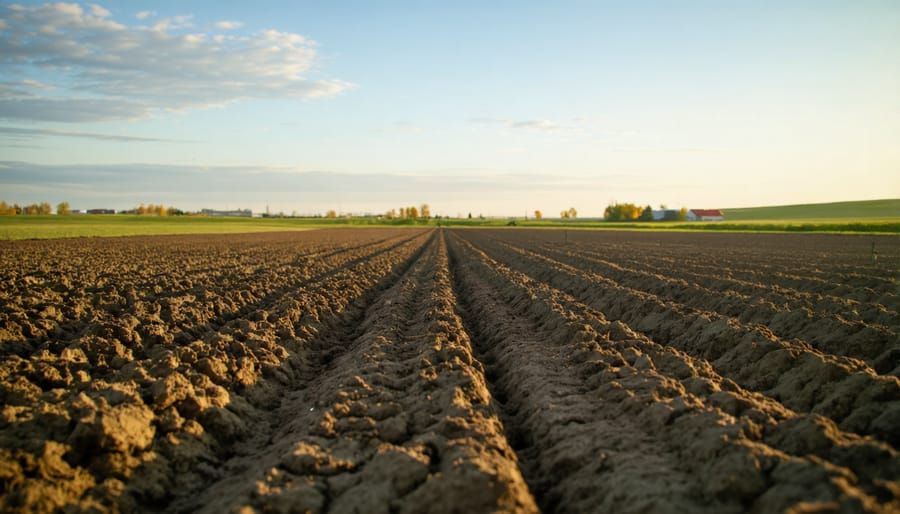
The Difference Between Water Conservation and Water Regeneration
While conservation focuses on reducing water use—installing efficient irrigation systems or timing applications to minimize waste—regeneration takes a fundamentally different approach. Think of conservation as doing less harm, while regeneration actively heals and improves your water systems.
Water regeneration creates beneficial cycles on your farm. Instead of simply using less water, you’re capturing rainfall, filtering it through living systems like constructed wetlands or vegetated swales, and returning cleaner water to aquifers or dugouts. This process mimics natural watersheds, where water continuously moves through soil, plants, and underground systems, getting purified and recharged along the way.
For Alberta farmers facing increasingly unpredictable precipitation patterns, this distinction matters. A regenerative approach might involve designing your fields to slow water movement across the landscape, allowing it to infiltrate rather than run off. You’re not just conserving the 100,000 litres in your dugout—you’re actively working to refill it through improved soil infiltration and strategically placed wetland areas that capture and clean runoff.
The result? You’re building water security while improving water quality, creating a resilient system that works with natural processes rather than against them.
Key Components of Farm-Scale Water Regeneration
A successful farm-scale water regeneration system relies on four interconnected components that work together to capture, clean, store, and redistribute water across your operation.
**Collection systems** form the foundation, gathering water from multiple sources including roof runoff, field drainage, and greywater from dairy operations or equipment washing stations. Many Alberta farmers are installing gutters and downspouts on barns and equipment sheds—structures that often sit unused as collection points. Consider that a 1,000 square metre barn roof can capture approximately 800,000 litres annually based on Alberta’s average precipitation.
**Natural filtration** processes the collected water through constructed wetlands, bioswales, or simple settling ponds. These biological systems use plants like cattails and native grasses alongside beneficial microorganisms to remove sediments, nutrients, and contaminants. Unlike mechanical filters requiring constant maintenance, these living systems become more effective over time while providing wildlife habitat.
**Storage infrastructure** ranges from dugouts and earthen ponds to above-ground tanks, depending on your land topology and frost considerations. Most Alberta operations benefit from partially buried storage to minimize freezing while maximizing gravity-fed distribution potential.
**Distribution systems** move regenerated water where it’s needed—whether through gravity-fed lines to pastures, drip irrigation for market gardens, or pumped systems for livestock watering stations. The key is designing for flexibility, allowing you to redirect water as seasonal needs change.
Each component scales to your operation size and can be implemented incrementally as budget and capacity allow.
Why Alberta Farms Need Water Regeneration Now
Alberta’s Changing Water Reality
Alberta’s water landscape is shifting in ways that directly impact your farm’s productivity. Over the past three decades, the province has experienced increasingly frequent drought conditions, with some regions seeing a 15-20% reduction in average annual precipitation. The 2021 drought alone affected over 70% of agricultural land, causing an estimated $1.8 billion in crop losses.
Snowpack levels in the Rocky Mountains—the source of much of Alberta’s irrigation water—have declined by approximately 30% since the 1950s. This directly affects summer water availability when crops need it most. The Oldman River Basin, for example, now experiences water shortages nearly every growing season, forcing irrigation districts to implement allocation restrictions.
Current water allocation systems face mounting pressure. Agricultural water use accounts for roughly 47% of total provincial water allocations, yet demands from municipal and industrial sectors continue growing. Many irrigation districts have implemented rotational schedules, reducing available water by 25-40% during critical periods.
These changes aren’t temporary setbacks—they represent Alberta’s new normal. Understanding these patterns is the first step toward climate-resilient farming. Water regeneration systems offer practical solutions to capture, store, and maximize every drop available on your operation, helping you maintain productivity despite these challenging conditions.
The Economic Toll of Water Scarcity
Water scarcity hits Alberta farmers where it hurts most—the bottom line. When irrigation costs climb and yields drop, the financial pressure becomes real and immediate.
Alberta producers currently spend between $150 to $400 per acre annually on irrigation, depending on their system and water source. During drought years, these costs can spike by 30-40% as farmers compete for limited water allocations. For a typical 500-acre operation, that’s an additional $22,500 to $60,000 in a single challenging season.
Crop losses tell an even starker story. Recent data from Agriculture and Agri-Food Canada shows that water-stressed wheat yields can drop by 25-50%, translating to losses of $125 to $250 per acre. For canola, the impact ranges from $100 to $200 per acre in reduced production. Scale that across your operation, and a moderate drought year can mean $50,000 to $125,000 in lost revenue for a mid-sized farm.
Livestock operations face their own challenges. Reduced pasture productivity forces earlier supplemental feeding, adding $1.50 to $3.00 per head per day in feed costs. Water hauling for remote pastures can cost $200 to $500 per load, with some producers making multiple trips weekly during dry spells.
These aren’t worst-case scenarios—they’re experiences many Alberta farmers faced during the 2021 drought. The good news? Water regeneration systems are helping producers reduce these costs while building long-term resilience.
Regenerative Water Management Strategies That Work
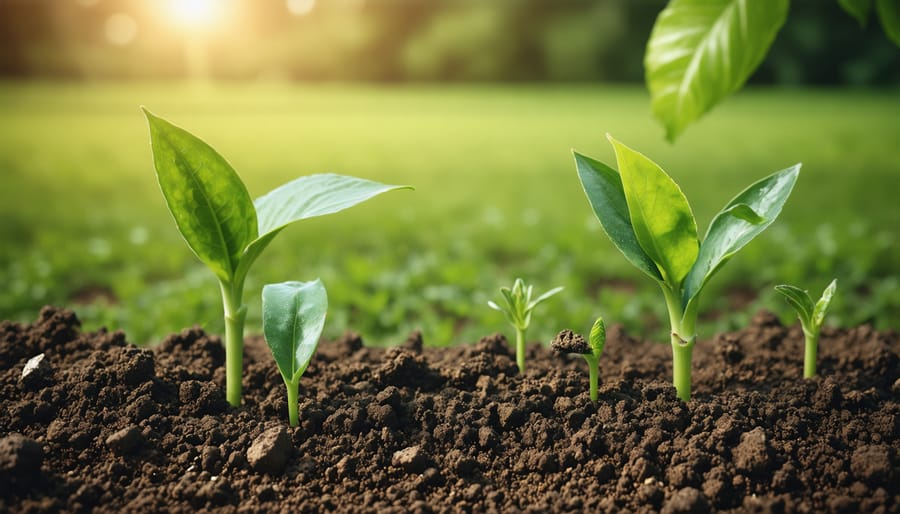
Soil as Your Water Battery
Healthy soil acts like a natural reservoir, capturing and storing water for when your crops need it most. By increasing organic matter in your soil, you can dramatically improve its capacity to hold moisture—research shows that each 1% increase in soil organic matter helps soil hold an additional 170,000 litres of water per hectare. For Alberta farmers facing unpredictable precipitation patterns, this becomes a game-changer.
The key is building soil structure through practical, proven methods. Start by incorporating cover crops like winter rye or hairy vetch between cash crop seasons. These plants add organic material while their root systems create channels that enhance water infiltration. Many Alberta producers have reduced irrigation needs by 20-30% after just three years of consistent cover cropping.
Reduce tillage whenever possible—leaving crop residue on the surface protects soil from evaporation and feeds beneficial microorganisms that bind soil particles together. Consider adding compost or well-aged manure at 10-20 tonnes per hectare annually to boost organic content.
“We cut our irrigation by a quarter after focusing on soil health,” shares Tom Hendrickson, a grain farmer near Lethbridge. “The soil just holds moisture better now, even during dry spells.”
Test your soil organic matter levels annually to track improvement. Most Alberta soils start at 2-4% organic matter, but with dedication, you can push toward 5-6%, significantly expanding your soil’s water-holding capacity.
Greywater Recycling for Agricultural Operations
Greywater recycling offers practical solutions for Alberta agricultural operations looking to reduce freshwater consumption while managing facility wastewater effectively. Dairy parlors generate significant volumes of washwater daily—typically 150-200 litres per milking cow—making them ideal candidates for recycling systems.
Modern greywater treatment systems use multi-stage filtration to remove solids, biological treatment to break down organic matter, and sometimes UV sterilization for pathogen control. Once treated, this water becomes suitable for various non-potable uses including equipment washing, barn floor cleaning, and irrigation of feed crops.
Manitoba dairy farmer Tom Henderson installed a greywater system in 2021 that now recycles 60% of his parlor washwater. “We’re saving approximately 40,000 litres weekly,” he notes. “The system paid for itself within three years through reduced water costs and effluent management fees.”
For equipment washing operations, greywater systems can capture rinse water from spray equipment and processing areas. The treated water meets quality standards for initial equipment rinses and facility cleaning, reserving potable water only for final sanitary rinses where required.
Start by auditing your operation’s water use patterns to identify the highest-volume greywater sources, then consult with agricultural engineers familiar with Alberta’s water quality regulations to design an appropriate system.

Constructed Wetlands and Bio-filtration Systems
Constructed wetlands offer a powerful solution for natural water filtration while creating valuable wildlife habitat on your farm. These systems use plants, microorganisms, and natural processes to remove nutrients, sediments, and contaminants from agricultural runoff before water returns to streams or aquifers.
For Alberta’s climate, design considerations are critical. Choose cold-hardy native plants like cattails, bulrushes, and willow species that tolerate freezing temperatures. Plan for 1.2-1.5 metres depth to prevent complete freeze-through during winter months. Position wetlands where they’ll receive runoff from feedlots, barnyards, or field drainage while maximizing sun exposure for spring thaw.
Bio-filtration systems—often called bioswales or vegetated filter strips—work alongside wetlands by slowing water flow and trapping sediments before they reach constructed wetlands. Plant these 5-10 metre wide strips with deep-rooted native grasses between fields and water features.
Many Alberta producers report reduced downstream pollution and improved water quality within two growing seasons. Start small with a 100-200 square metre demonstration wetland to understand maintenance requirements before scaling up. Local watershed stewardship groups often provide design assistance and may offer cost-share programs for construction.
Rainwater Harvesting and Strategic Storage
Capturing rainwater from your barn, shop, and home roofs provides a reliable water source that reduces dependence on wells or municipal supplies. For every millimetre of rainfall on a 100-square-metre roof, you can collect approximately 100 litres of water—meaning a typical prairie storm delivering 25mm could yield 2,500 litres from that same roof area.
Start by calculating your storage needs based on seasonal rainfall patterns and livestock requirements. A cow-calf pair needs roughly 70-100 litres daily, while irrigation demands vary by crop and growth stage. Alberta producers often aim for 30-60 days of storage capacity to bridge dry periods between precipitation events. This translates to 10,000-50,000 litres (10-50 cubic metres) for most diversified operations.
Install food-grade storage tanks equipped with first-flush diverters to remove initial roof debris, and ensure proper filtration before use. Many Alberta farmers successfully use above-ground polyethylene tanks (2,000-10,000 litre capacity) connected in series, positioned strategically near livestock watering areas or garden plots. Underground cisterns offer freeze protection but require professional installation. Consider overflow management directing excess water to swales or ponds, creating a cascading system that maximizes every drop while preventing erosion.
Real Alberta Farms Making It Work
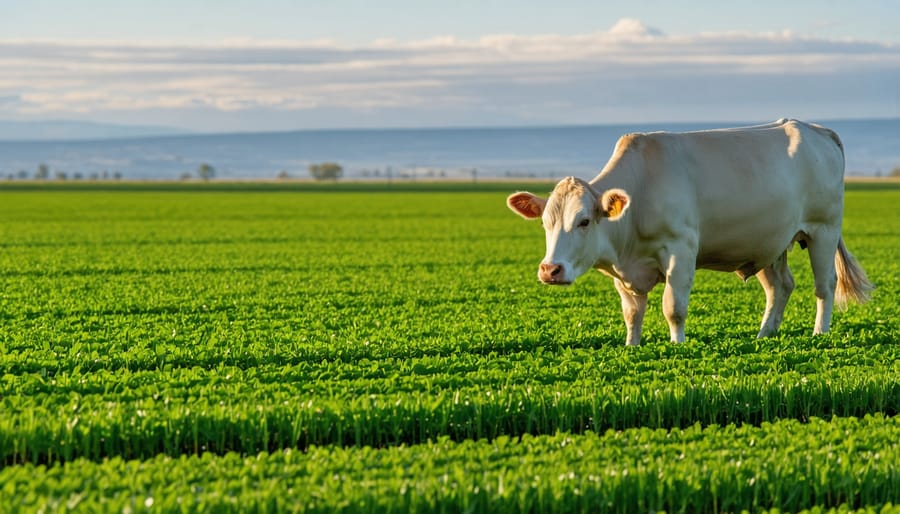
Case Study: Mixed Grain and Cattle Operation Near Red Deer
When Rob and Jennifer McKenzie started noticing declining water levels in their dugouts during Alberta’s increasingly dry summers, they knew their 1,200-acre mixed operation needed a comprehensive approach. Located 20 kilometres east of Red Deer, the McKenzies integrated three water regeneration strategies over a 24-month period.
They began with riparian area restoration along their seasonal creek, planting native willow and buffaloberry on 400 metres of streambank. This initial investment of $3,200, partially offset by Growing Forward funding, reduced sediment flow by an estimated 60% within the first year.
Next came keyline cultivation across 80 acres of degraded pasture. “We hired a contractor for $42 per acre because the learning curve was steep,” Rob explains. “But we immediately saw better water distribution after spring melt.” The improved hydration allowed them to extend their grazing season by three weeks.
The final piece was installing two small retention berms with overflow spillways near their cattle watering areas, capturing and slowly releasing runoff. Total material and equipment costs ran $1,800.
Combined results after two years: dugout water levels remained 1.2 metres higher through summer, pasture productivity increased approximately 25%, and they eliminated emergency water hauling that previously cost $2,500 annually.
Jennifer’s advice? “Start small with one strategy. We learned that observation matters more than perfection—watch where water naturally wants to go, then work with it instead of fighting it.”
Case Study: Organic Vegetable Farm in Southern Alberta
When Mark and Jennifer Chen transitioned their 8-hectare vegetable operation near Lethbridge to a water regeneration system in 2021, they were facing rising water costs and increasing irrigation restrictions during Alberta’s dry summers. Their solution combined greywater recycling from their farm’s washing and processing facilities with a constructed wetland filtration system.
The regenerated water feeds directly into their drip irrigation network, serving high-value crops including tomatoes, peppers, and leafy greens grown in hoop houses and field rows. The system processes approximately 15,000 litres of water daily during peak season, recovering water that previously went to waste.
“We installed a three-stage treatment process: settlement tanks, a bio-filter with native wetland plants, and UV disinfection,” explains Mark. “The initial investment was $28,000, including labour and materials. Within two growing seasons, we’d recovered those costs through reduced municipal water bills and increased production capacity.”
The results speak for themselves. The Chens reduced their municipal water consumption by 65 percent while expanding their irrigated area by 30 percent. Their drip system delivers regenerated water precisely where needed, minimizing evaporation and runoff. Soil moisture monitoring ensures optimal delivery, and regular water quality testing confirms the regenerated water meets safety standards for food crops.
Beyond the financial return, the system has strengthened their market positioning. Local restaurants and farmers’ market customers actively seek out their produce, appreciating the farm’s commitment to water stewardship. “It’s become part of our story,” Jennifer notes. “Customers care about how their food is grown, and sustainable water management resonates strongly.”
Getting Started: Your Water Regeneration Action Plan
Assess Your Farm’s Water Flow
Start by walking your property with a notebook during different weather conditions to observe where water naturally flows, pools, and exits your land. Map these patterns alongside your current infrastructure—wells, dugouts, irrigation systems, and drainage tiles. This visual audit helps you see both opportunities and problems you might have missed.
Next, calculate your water inputs and outputs. Measure how much water you’re drawing from wells or municipal sources monthly, and estimate where it goes—livestock consumption, crop irrigation, cleaning operations, and household use. Don’t forget to track seasonal variations, as Alberta’s climate creates significant fluctuations between spring melt and summer drought periods.
Identify waste streams that could become resources. Look for runoff from buildings, excess irrigation water, and areas where precipitation quickly leaves your property instead of infiltrating the soil. Alberta farmer James Koole discovered he was losing 40% of his rainfall to rapid runoff before implementing regenerative practices.
Finally, pinpoint specific opportunities: Could that low-lying area become a retention pond? Would swales along field edges slow water movement? Could you capture roof runoff for livestock watering? These observations form your roadmap for designing a water regeneration system tailored to your farm’s unique landscape and needs.
Start Small and Scale Up
You don’t need to overhaul your entire operation overnight. Starting with a pilot project lets you test water regeneration strategies on a manageable scale while building practical knowledge and confidence.
Consider beginning with a single field or paddock where you implement one or two practices—perhaps adding a small retention pond with swales or establishing cover crops in a 10-20 hectare area. This approach allows you to observe results, troubleshoot challenges, and calculate actual returns before expanding.
Many Alberta farmers find success by starting with smart water technology like basic soil moisture sensors in test plots. These tools provide concrete data showing how your changes affect water retention and crop performance, making it easier to justify larger investments.
Track simple metrics: soil moisture levels, water storage capacity, and crop yields in your pilot area compared to conventional sections. Document your labour hours and costs honestly. This baseline information becomes invaluable when seeking grants, loans, or simply deciding your next steps.
Success in small sections builds momentum. You’ll develop hands-on experience, identify what works for your specific conditions, and create a proven model to replicate across your operation.
Navigating Regulations and Permits in Alberta
Implementing water regeneration systems in Alberta requires navigating several regulatory layers. Start with Alberta Environment and Parks (AEP), which oversees water allocation and diversion permits through the Water Act. Most on-farm water management systems require a Water Act authorization, particularly if you’re capturing, storing, or redirecting water beyond basic livestock watering.
The Agricultural Service Board in your municipality can guide you through local requirements and connect you with regional agrologists familiar with water regulations. They’re an invaluable resource for understanding what applies to your specific operation.
For greywater reuse systems, consult Alberta’s Private Sewage Systems Standard of Practice, which outlines treatment and disposal requirements. While regulations may seem complex, many Alberta farmers have successfully obtained permits by working closely with AEP regional offices. Submit your applications early—processing typically takes 60-90 days.
Consider connecting with the Alberta Water Council for updates on policy changes affecting agricultural water use. Their resources help you stay compliant while optimizing your regeneration system’s design to meet both regulatory standards and your farm’s sustainability goals.
Funding and Support Options
Canadian farmers have access to several funding streams to support water regeneration investments. Agriculture and Agri-Food Canada’s Canadian Agricultural Partnership offers cost-share programs covering up to 50-70% of eligible expenses for water management infrastructure. Alberta farmers can tap into the On-Farm Climate Action Fund, which provides financial support specifically for water conservation projects and soil health improvements.
The Farm Water Supply Program through Alberta Agriculture and Irrigation offers grants for dugout construction, pipeline installation, and water storage systems. Many provincial programs prioritize projects demonstrating environmental benefits like reduced water consumption or improved watershed health.
Local conservation districts often provide technical expertise alongside financial incentives, helping you navigate applications and maximize funding opportunities. Farm Credit Canada also offers specialized financing for sustainability projects with favorable terms. One Alberta cattle producer secured $45,000 in combined federal-provincial funding for their regenerative water system, covering nearly 65% of implementation costs. Contact your regional agricultural fieldman to identify programs matching your operation’s specific needs and explore stacking multiple funding sources for maximum support.
Expert Insights: Making Water Regeneration Systems Work in Cold Climates
We spoke with Dr. Sarah Kowalski, an agricultural water systems specialist with over 15 years of experience working with prairie farmers, about the unique challenges of operating water regeneration systems in Canadian climates.
**Winter-Proofing Your System**
“The biggest concern I hear from Alberta farmers is freeze-thaw cycles,” Dr. Kowalski explains. “The good news is that with proper planning, these systems can operate year-round.” She recommends insulating all exposed piping with closed-cell foam rated for -40°C and installing heat trace cables on critical components. “Many producers also benefit from housing pumps and filtration units in insulated pump houses or partially below ground where temperatures remain more stable.”
For constructed wetlands and retention ponds, Dr. Kowalski emphasizes the importance of adequate depth. “In our climate, you need at least 1.5 to 2 metres of depth to prevent complete freezing. Ice cover actually provides natural insulation for the biological processes happening below.”
**Seasonal Operation Adjustments**
Marc Beauchamp, a water management consultant who’s helped implement systems across Western Canada, offers practical advice for seasonal transitions. “Don’t try to push full capacity in winter,” he cautions. “Biological filtration naturally slows in cold weather. Reduce your flow rates by 30-40% between November and March, and you’ll maintain water quality without overtaxing the system.”
He also recommends installing bypass valves. “This gives you flexibility when conditions aren’t ideal. You can redirect water temporarily without shutting down your entire operation.”
**Troubleshooting Common Challenges**
When asked about the most frequent issues, Dr. Kowalski points to monitoring gaps. “Farmers sometimes assume if it worked in summer, it’ll work in winter. Install temperature sensors at multiple depths and check dissolved oxygen levels weekly during cold months. Catching problems early prevents costly repairs.”
Both experts emphasize the learning curve. “Your first winter is about observation,” Beauchamp notes. “Document everything—flow rates, temperatures, any issues you encounter. By year two, you’ll have a personalized operation manual that works for your specific conditions.” This knowledge becomes invaluable, especially as you work toward optimizing efficiency across all seasons.
Water regeneration systems represent more than just another farming practice—they’re a fundamental shift toward building resilient operations that can thrive despite increasing water uncertainty. For Alberta farmers facing extended drought periods and unpredictable precipitation patterns, these systems offer a practical pathway to securing your water future while enhancing soil health, improving crop yields, and reducing operational costs.
The opportunity before us is significant. Farms that have implemented regeneration strategies are seeing measurable results: reduced irrigation costs by 20-40%, improved water retention during dry spells, and healthier, more productive soils. Beyond individual operations, these practices strengthen entire communities by maintaining aquifer levels, reducing strain on municipal water supplies, and creating more stable agricultural economies.
The environmental stewardship aspect cannot be overlooked. Every hectare managed with water regeneration principles helps restore natural hydrological cycles, supports local biodiversity, and contributes to climate resilience across the prairie landscape. You’re not just managing your farm—you’re actively participating in the restoration of Alberta’s water systems for future generations.
Starting doesn’t require overhauling your entire operation overnight. Begin with one practice: test contour planting on a single field, establish a small retention pond, or integrate cover crops into your rotation. Connect with your local agricultural extension office, reach out to neighbours who’ve implemented these systems, and explore available funding programs through provincial water management initiatives.
The time to act is now. Water challenges won’t wait, but neither should the solutions. Your farm, your community, and Alberta’s agricultural future depend on the choices we make today. Take that first step—the resources, knowledge, and support are available to help you succeed.

